
ELECTRICAL POWER
Challenge
Your city has suffered a direct hit from a powerful hurricane. Thousands of power poles are taken down by high winds, leaving your community without electricity. Authorities indicate that it will be anywhere from two to four weeks before power is fully restored. How will you perform basic functions like keeping warm at night, washing clothes, cooking food, and lighting your home?
Our modern society depends on electrical power for its needs and conveniences; from providing heat, to cooking, to powering our televisions and telephones, we need electricity. Unfortunately, electrical power is often the first service to fail in a crisis. Loss of power can be the result of many different events, including downed trees, power grid failures, vehicle collisions, ice storms, and high winds, to name just a few.
Being without electricity for a few hours is usually little more than annoying, perhaps missing your favorite football game, or having to eat dinner by candlelight. However, as those who have experienced extended blackouts can testify, being without electrical power for more than a few days can introduce real hardships.
Let's begin with an explanation of a few electrical terms. A useful analogy compares electricity to water. Just as water flows through pipes, electricity flows through wires. Water pressure forces water to move, and electrical pressure, known as voltage, forces electrons to move. The higher the pressure, the more water (or electrons) flow in a given amount of time. This flow of electricity—quantified by counting the number of electrons that pass in a given amount of time—is called current, and is measured in amps. If you multiply the voltage and current together, the result is power, which is measured in watts. More generally, the resultant is in volt-amps, but for our purposes, we can neglect this detail. Power can be thought of as the amount of usable energy at any given time that is being delivered to a device.

The flow of electricity is analogous to the flow of water.
There are two types of current: direct current (DC), and alternating current (AC). With DC, current flows in one direction—from point A to B, perhaps from the battery to your cell phone. Alternating current is a bit more complicated. With AC, current flows from point A to B, and then reverses direction, flowing from B back to A. For your house power, this reversing action occurs sixty times in a single second, with the number of cycles being measured in the unit of hertz (Hz). If you live outside the United States, the AC frequency may be different (perhaps operating at 50 Hz), but the principles of alternating current flow remain the same.
Your electric power company generates AC electricity and distributes it to your home using overhead or buried wires. For efficiency reasons, this electricity is transmitted at very high voltages (perhaps hundreds of thousands of volts). When the electricity gets close to your neighborhood, it is stepped down to a more usable voltage using transformers. The electricity is then routed into your home over three wires: two 120-volt “hot” lines, and one “neutral” line. The three wires can be configured as 120 volts and 240 volts (see figure on next page).
House wiring
Most of the electronic items in your home are powered by 120 volts AC. Your dishwasher, house lights, televisions, and stereos all require standard 120-volt AC power. A few high-power appliances, such as clothes dryers, air conditioners, and stoves, may require 240 volts. Portable devices that plug into an electrical socket for recharging (e.g., laptop, handheld gaming device, cell phone) convert the 120-volt AC voltage into a DC voltage either internally or through a small converter module in the cable or plug.
To develop a DP plan for electricity, start by determining your electrical needs—both AC and DC, and then select and size a method to provide this level of electricity.
Providing your own AC power is generally done in one of two ways: using fuel-burning generators or battery-powered inverters. Other more exotic options, such as steam, hydroelectric, and wind-powered generators, are generally not practical for individuals due to high costs and low-power output.

Generating AC power is done using generators or inverters.
Generators are fuel-burning engines that generate AC electricity. Most run on standard gasoline, diesel, propane, or natural gas. They are rated according to the maximum power they can produce—typically measured in 1,000s of watts (a.k.a., kilowatts). Generators must be placed outdoors because, like all gas-powered engines, they vent poisonous exhausts. They also require regular maintenance, including changing the oil, replacing spark plugs, and cleaning filters.
Generators are classified as either standby or portable. Standby generators are permanent units mounted outside your home or office to provide backup power. They are usually configured to automatically turn on when power drops out. Most standby generators are fueled by propane or natural gas. They are very expensive, but offer an excellent solution to power outages. If money is no obstacle, then having your home configured with a large standby generator is the optimal solution to meeting your electrical needs.
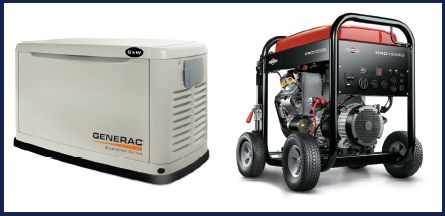
Standby and portable generators (courtesy of Generac and Briggs and Stratton)
Portable generators are the type seen frequently at home repair stores. As their name implies, these units are wheeled outdoors and put into service only when the need arises. Portable generators typically run on either gasoline or diesel fuel.
The biggest shortcoming of portable generators is that they burn a lot of fuel. Using them as a direct replacement for your utility power is not practical. The best way to illustrate this is through an example.
Example: A 10-kilowatt gas-powered generator burns roughly 2 gallons of gas per hour. To run it for a full twenty-four-hour day would require 48 gallons of gas. To run it constantly for a week would require over 300 gallons of fuel!

A generator burns a lot of fuel. Limit your use to only a few hours each day.
It is not practical to store this amount of fuel since it would present a tremendous fire hazard, and almost certainly void your homeowner's insurance policy. For this reason, portable generators are best used to provide short-term electrical power needs, sometimes spread across a long period of time. (See “Draw up a Schedule” for more details on effectively using a generator.)
If you are planning to use a generator for emergency power needs, you will need to make five important preparations (see tip box).

Preparing for Generator Use
1. Select the right size and type of generator.
2. Have the necessary hardware installed in your home.
3. Draft a schedule of how you will use it in an emergency.
4. Stockpile the necessary fuel.
5. Learn how to use the generator safely.
Begin by selecting the right type and size of generator. First, decide whether you need a standby or portable generator. Standby units are permanent systems professionally set up outside the home or business. Portable generators are the type you roll out of the garage when needed. Next, select the type of fuel you wish to use. Most portable generators burn either gas or diesel. Generators that you find at your local hardware store will usually be gas-powered, portable units. Diesel generators are more expensive (perhaps double in price) but also more durable and require less fuel. Diesel fuel is also less combustible than gasoline.
Whatever type of generator you select, it should be large enough to meet your electrical needs. Resist the temptation to drastically oversize the unit. Generators are typically most efficient when the load is about 70 percent of the rated generator capacity.133 To properly size a generator, make a list of those items that will require electrical power. Pay special attention to the voltage that your heating/air unit requires. If it runs on 240 volts, and you plan to power it during an emergency, you will need to select a generator that outputs both 120 and 240 volts.

When sizing your generator, don't forget to account for surge currents.
Generators are sized with both “constant power” and “surge power” ratings. Make certain that the generator you select provides enough constant and surge power for your particular loads. Anything with a motor requires additional surge power during startup. Total constant power is determined by adding up all the constant power loads that will be running concurrently. To calculate total surge power, determine the extra surge power needed for your single largest appliance, and then add that difference to your total constant power value. You don't need to add up all the surge values because operationally you will ensure that you only start up one appliance at a time.
To make an accurate list of power usage, check appliance labels and product paperwork for power requirements. The amount of electricity listed on an appliance is the maximum it uses, such as when a refrigerator's compressor is running. The normal standby level may be much less. Some devices also consume a small amount of power even when turned off. To get the most out of your power source, it is best to unplug anything that isn't being used.
Table 6-1 lists example power requirements for common electrical appliances. Your loads may be different, but this table gives you a point of reference. You can also directly measure an appliance's power consumption using inexpensive electricity usage meters, such as the Kill A Watt.
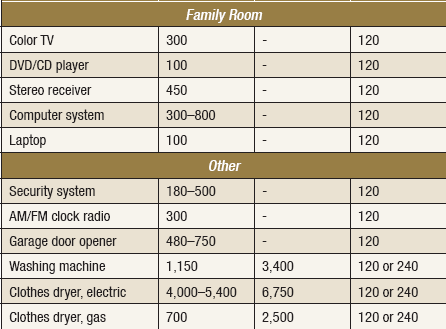
Once you have selected your generator, decide how it is to be used. There are two different methods of using a generator: direct and whole house.
With the direct method, you plug lamps and appliances directly into the generator sockets. Every generator is equipped with a different set of sockets, so before purchasing, check that the generator has the right plugs for your appliances. All generators offer numerous standard 120-volt AC sockets, but some also provide 240-volt AC, or even 12-volt DC sockets—useful for recharging lead-acid batteries.
Since generators can only be used outdoors, heavy-duty extension cords are needed to connect your appliances to the generator. The direct method is inherently safe to your home's electrical system. It also requires very minimal setup since there is no hardware to install. A serious drawback of direct generator use, however, is that you can only power equipment that has a standard AC plug. This means that you can't easily power your water heater, house lights, or heat pump—all of which can be very important. Direct generator use is also inconvenient for powering several appliances located in different rooms of your house, since each one requires its own extension cord.
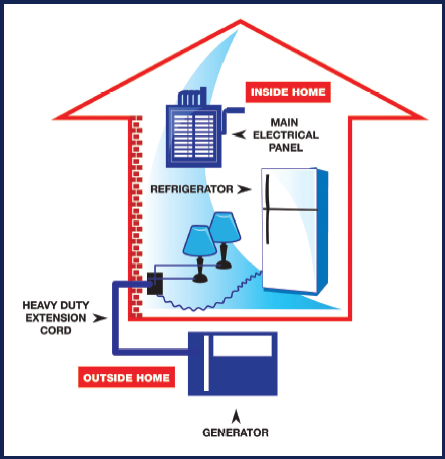
Direct generator connection
With the whole house method, the generator is connected to your home's electrical system. This allows you to use your wall sockets and lights as you normally do today. Using a generator to power your whole house requires that you install a mechanical interlock or transfer switch. This work should only be done by a licensed electrician. Mechanical interlocks and transfer switches are hardware devices that transfer the source from which your home draws electricity, choosing between the power company's lines or your generator. Interlocks and transfer switches both perform the same general function but in very different ways.

To power your home using a generator, you must use an interlock or transfer switch.
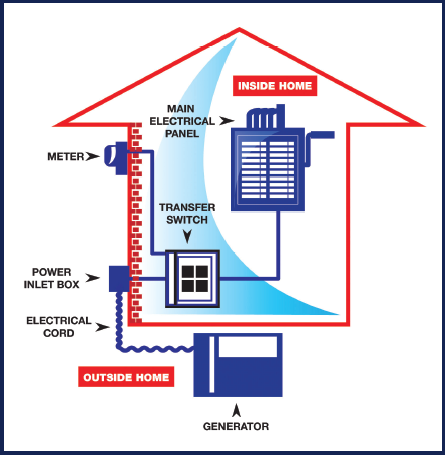
Whole house generator connection
The simpler of the two mechanisms is the mechanical interlock. An interlock manually switches your home's main breaker off anytime you switch your generator's breaker on. The interlock is a custom-fitted piece of metal that mounts inside your existing breaker box. This is the cheapest method to connect your generator to your home's electrical system, requiring only the mechanical linkage (installed inside your panel), a generator breaker (also installed inside your panel), and a power inlet box (installed outside where you wish to plug in the generator). Mechanical interlocks have the advantage of allowing you to power up any of your home's appliances using the existing secondary breakers.
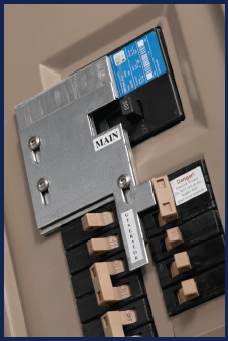
Expect to pay a few hundred dollars to have a licensed electrician perform the installations. This is not a do it yourself job since wiring your home without a license can void your homeowner's insurance, not to mention kill you.

Mechanical Interlock Use
1. Turn off the main breaker.
2. Shut off all the home's circuit breakers.
3. Make sure the interlock is in the home position.
4. Connect and start the generator.
5. Slide the interlock into the generator position.
6. Turn on desired breakers one at a time, giving each load a moment to stabilize before throwing the next breaker.
A second method of using a generator is to connect it through a transfer switch that contains its own set of breakers. For this type of installation, the electrician moves wires from your main breaker panel and connects them to the transfer switch breakers—usually mounted next to your existing panel. The transfer switch has only a limited number of breakers, so you will likely have to make some sacrifices as to what systems you power from the generator.
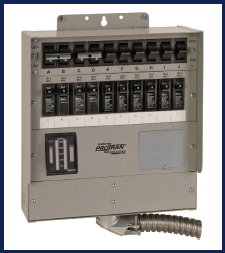
Transfer switch (courtesy of Reliance Controls)
This limitation forces you to allocate transfer switch breakers, starting with the most important loads first (e.g., water heater, cooking range, lights). If you use this method, select a transfer switch that has at least twelve breakers. Some transfer switches have large sockets that allow you to plug the generator directly into them using a heavy-duty cord. If the transfer switch doesn't have a socket, you must install a power inlet box outside the house near the generator. One advantage of transfer switches is that they often have power meters to show the level of power going out to the house loads. This feature helps to prevent overloading of the generator.
Having an interlock or transfer switch is absolutely necessary to power your home's wall sockets and overhead lights. If you wire a generator directly into your home's electrical system without one of these isolation devices, you risk backfeeding the power lines, which can electrocute line-men working to restore electricity. There are stories of people turning off their main breaker and wiring a generator to their dryer socket in an emergency, but it is simply not worth the risk to your home, your family, and the hard-working linemen. Do it right or don't do it at all.
In theory, wiring a generator to your existing breaker panel using an interlock or transfer switch should enable you to use your home appliances just as you do today. In reality however, you will have to take into account the capabilities of the generator. It is very likely that the generator will be unable to power all your appliances simultaneously. For that reason, you will need to limit the electrical load to only what is absolutely needed at the time. This prioritizing is accomplished by keeping off some of the breakers in your main power or transfer switch panel. You may have to cycle some appliances in and out, perhaps waiting for the washing machine to finish before turning on your space heater. If you overload your generator, it will choke out the engine and may even damage the unit over time.
Once you have compiled the list of equipment you want to power, and have all the hardware installed, draw up a schedule detailing how you will operate the generator. For most situations, it is best to run the generator for a couple of hours in the morning and a couple more at night. The goal is to take care of all your day's electrical needs during these few hours. Activities could include:
• Recharging your batteries and handheld devices (cell phones, laptops, radios) ajd as df soaijf sajdf lsajfsajf osauf oasufiouas fas fusafousa fusa fusa fsaf u a dfj askjf aosjf oiasf asf asf as fas f
• Heating or cooling the house
• Cooking the day's meals
• Cooling the refrigerator and freezer
• Heating the water in the hot water heater
• Tuning in to TV, radio stations, or shortwave broadcasts
• Washing and drying clothes
• Operating your water pump (if using an underground well) to flush commodes and replenish your water supply
Adopting a usage plan like this will still leave you without AC power for most of the day, so life is certainly not going to be normal. However, with brief periods of electrical power, your family will be able to better prepare for the coming day or night.

Consult your insurance provider regarding fuel storage to prevent voiding your policy.
Another important preparation is to stockpile sufficient fuel to handle your generator needs. Consult your homeowner's insurance provider and local fire department to determine how much fuel may be stored without voiding your policy or violating local law. The nation's Uniform Fire Code limits storage to 25 gallons, but local regulations may supersede this rule. If you want to prepare for a weeklong power outage and are operating on a four-hour daily schedule, you will likely need between 30 and 60 gallons of gas—some of which you may wish to pick up just before the emergency. The exact level depends on the size of your generator and how heavily you load it. If you have a diesel generator, you may only need about 20 to 40 gallons since they typically burn less fuel per kilowatt-hour.
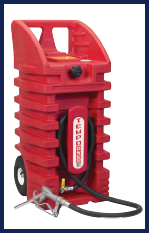
Moeller Marine gas caddy
Store fuel in UL-approved containers in a well-ventilated area (most likely your garage or a nearby shed). Never store fuel inside your home. Gas and diesel are both environmental hazards, and storing them underground is strictly regulated, making it very expensive for an individual to do so legally. Given these restrictions, you will probably end up using jerry cans, or slightly higher-capacity fuel caddies. Note that 60-gallon metal drums are the only large fuel containers approved by the Uniform Fire Code. However you decide to store it, fuel must either be in a container light enough to lift, or one that is able to be pumped or siphoned. Remember that siphoning only works when transferring to a level below the fuel level. If the fuel level in your gas container is at two feet off the ground, and your generator fuel tank is at three feet, you will not be able to siphon fuel into the generator.
Over time, gasoline deteriorates, losing octane and turning to a gummy lacquer-like substance. Under optimal conditions, gasoline can be stored up to one year.135 Optimal conditions are defined as out of sunlight, at a constant, moderate temperature (<80°F), and in a tightly closed container. A more conservative recommendation is to consume or replace your fuel within six months. This requirement presents a dilemma. Fuel has a relatively modest shelf life, and yet you only need it when power fails—something you certainly can't schedule.

Gasoline should be used or replaced every six months.
Fortunately, fuel can be treated with special additives that help extend its shelf life. Two very popular products for this are PRI-D/G and STA-BIL. By adding a stabilizer, fuel may last for several years. These products mix at small ratios, so very little is needed. If you are going to store fuel, preservatives are a necessity.

Fuel stabilizers (courtesy of STA-BIL and PRI-G)
To learn how to use a generator correctly, begin by consulting the operator's manual that comes with your specific unit. A few things are common regardless of the particular model. You will need to add oil and fuel, as well as install one or more filters. To start the generator, either use the pull string or electronic ignition button. Below are some additional operating tips:136
• Always operate the generator outdoors. Never use it in a garage, crawlspace, or shed. Generators exhaust a great deal of pollution that must be safely vented outdoors.
• Maintain a safety zone of at least four feet around the generator. Generators situated too close to a home can melt siding or cause a fire.
• Identify the exhaust port and ensure that it faces away from your home. Close all nearby windows or doors to prevent the exhaust from entering your house.
• Before refueling, shut down the generator and allow it to cool for a few minutes. Fuel spilled on a hot generator can ignite.
• Don't overfill the gas tank. Leave a couple of inches of space at the top to allow for the fuel to expand as it heats up.
• Wipe up any fuel spills before starting the generator.
• Keep the generator dry. Don't operate it in the rain unless it is covered with a overhead canopy.
• Be mindful of the generator's power rating, and try not to exceed it. A generator will choke out if overloaded.
Inverters are a less expensive option for generating AC power. They convert DC battery voltage into AC voltage. Similar to generators, they are rated by the maximum power they output. Small inverters provide up to a few hundred watts, while larger ones can output several thousand watts. There is little need for inverters larger than this because they would quickly drain any reasonable-sized battery source.
Most inverters accept 12 or 24 volts DC as input, and output 120 or 240 volts AC through standard three-prong outlets. The 12-volt input makes them convenient to use since they can be connected directly to automotive or marine batteries.
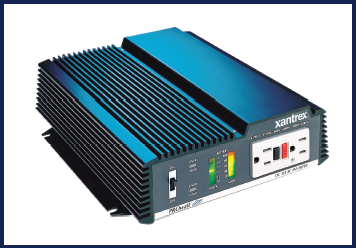
Xantrax inverter
Inverters are designed for direct plug applications only, routing power to your devices through extension cords. Don't connect an inverter to your home wiring. There is a danger of making the battery terminals live with the full 120-volt AC level.137
Most inverters are classified as modified sine wave devices. This means their output is not a true sine wave but a distorted representation. Normally this imperfection is not a problem since most electronic equipment will run fine without perfect sine wave power. However, some sensitive electronics, such as computers and televisions, may not operate properly with modified sine wave inverters. For those devices, you may need a more expensive, true sine wave inverter.
Inverters are not designed to power devices with high startup currents, such as washers, refrigerators, or heat pumps (see Table 7-1). Many inverters offer “soft start” circuitry to slowly bring up the current level. This may help power up some equipment with higher surge requirements.

Caution: Many inverters don't have reverse polarity protection. To avoid damage, pay attention when connecting the battery input terminals.
Features you may wish to consider when selecting an inverter include:
• Overload and high temperature shutdown
• Low-voltage alarm and shutdown
• Soft starting to better handle surge currents
• Low idle current
• Overload protection
• Battery monitor
Inverters are not a direct replacement for generators for three reasons: they don't output as much power; they are not able to start up equipment with high surge currents; and they require large battery banks to output significant amounts of sustained power. An example will make this last point clear.
Large Load Example:
Assume you wish to use an inverter rated at 2,000 watts to power a space heater and a computer that require a total of 1,900 watts. You connect the inverter to a 12-volt, 100 amp-hour car battery (pulled out and sitting on the floor in this case). Although not precisely accurate, the 100 amp-hour rating will be taken to mean that the battery can output 100 amps for 1 hour, or 1 amp for 100 hours. The total available power is calculated as 12 volts × 100 amp-hours = 1,200 watt-hours.
The inverter is rated as 90 percent efficient, meaning that 90 percent of the power that goes into it is usable, and the remaining 10 percent is lost in heat. To output the 1,900 watts of AC power from the inverter requires 2,111 watts of DC power from the battery. This converts to only about half an hour of run time before the battery is completely drained (1,200 watt-hours capability ÷ 2,111 watts needed = 34 minutes).
This example illustrates that running a modest load of 1,900 watts for any reasonable length of time will require a significant bank of batteries. You might think that this limitation can be circumvented by keeping the battery in your vehicle and using it while the engine is running. The problem is that an alternator typically only outputs 600 to 800 watts, so it can't keep up with your load. The battery will still deplete rapidly. You may also experience car problems, such as overheating the alternator.
A particularly effective backup electrical system consists of a generator, battery bank, and an inverter. Teamed together, the three allow you to function with limited capacity throughout the entire day. The generator is used to provide high-current needs, such as cooking and clothes washing for a few hours each day. It is also used to recharge the battery bank. The batteries and inverter are used to provide for the day's lower power needs, such as radios, lamps, computers, and small appliances.

When combined, a generator, inverter, and bank of batteries form an effective backup electrical system.
Batteries provide DC power to portable devices, such as flashlights, cameras, cell phones, weather or pocket radios, and remote controls. There are many different types of batteries available, each with its respective advantages and shortcomings.
Batteries should be stored in a cool, dry location. Some people store batteries in the refrigerator thinking that the cool temperatures will help the shelf life. Studies have shown that the cool temperatures do help to slow the chemical reaction and increase battery shelf life, but only by a few percent—hardly worth the effort. Refrigerated batteries should always be warmed up prior to use. Not only do batteries have higher output levels when warmer, but if they are not allowed to warm, condensation can form inside the electronic device being powered.138,139
You will need to decide between single-use or rechargeable batteries. The advantages of single-use batteries are their low cost and good shelf life. Rechargeable batteries offer many more hours of use (assuming you can recharge them repeatedly), but generally suffer from poor shelf life and self-discharge. Most rechargeable batteries also require charging before using them the first time.
Below are tables comparing the most common types of single-use and rechargeable batteries.140,141,142,143,144,145
There are four common types of single-use batteries: heavy duty, alkaline, nickel oxyhydroxide, and lithium. They can be compared using four metrics: cost, likelihood of leaking, energy density, and shelf life (how long they can sit on a shelf and still be usable, holding at least 70 percent of charge). See Table 6-2 for a comparison across these metrics.
Given their low cost and reasonable performance, alkaline batteries are the preferred choice for general purpose uses. For improved performance, such as in cameras, consider using nickel oxyhydroxide batteries. Finally, if cost is not an issue and you want the very best, select lithium batteries for their outstanding performance and shelf life.
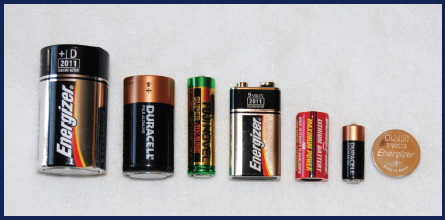
An assortment of single-use batteries
Rechargeable batteries are compared using slightly different metrics, as shown in Table 6-3. The good news is that they aren't prone to leaking, and their energy densities are comparable to single-use batteries. Unfortunately, rechargeable batteries suffer from self-discharge. This means that even when just sitting on the shelf, they will discharge—some very rapidly. Their initial costs are also higher than single-use batteries, but they offer the advantage of numerous recharges, making them much cheaper to use over the long run.

To reduce the chances of batteries leaking, only pair up batteries that come from the same package at the same time.
Rechargeable batteries are great for daily-use devices because they can be recharged hundreds of times. However, because of their self-discharge and shorter shelf life, most are not ideal for disaster preparedness. To keep several sets of rechargeable batteries ready for use would require cycling them in and out of the charger every month—both inconvenient and easy to neglect. Most rechargeable batteries are also not suited for devices that are expected to last for many months, such as clocks or remote controls because once again, the self-discharge makes it necessary to do frequent battery cycling.
Low self-discharge NiMH batteries are a new addition to the battery world. They still allow hundreds of recharge cycles but have a much lower self-discharge rate, meaning that once charged, they will remain ready to use for a year or more. Low self-discharge NiMH batteries are also marketed as “ready to use,” “pre-charged,” or “hybrid” batteries, and generally come charged right out of the package. Although more expensive initially, pre-charged NiMH batteries are an excellent choice for nearly any need—including disaster preparedness.

Low self-discharge NiMH batteries allow hundreds of recharges and have reasonable shelf life.
Lithium-ion batteries offer excellent initial energy capacity but suffer from a unique problem. They degrade in capacity about 20 percent per year due to rising internal resistance. After a couple of years, they are no longer usable for most applications. For this reason, lithium-ion batteries are not recommended. Additionally, they are typically only available in sizes suitable for camera use.
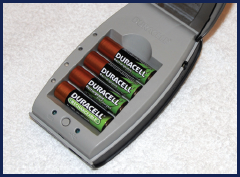
Pre-charged NiMH batteries in charger
Lead-acid batteries are large rechargeable batteries typically used in your automobile or boat. They have low energy-to-volume ratios, meaning they are large in size for the power they output. However, lead-acid batteries can supply the high surge currents needed to start motors. Most batteries have an output of a little over 12 volts when fully charged.
Lead-acid batteries are rated by several metrics, the most important of which is their sustained output capability (measured in amp-hours). The amp-hour rating indicates how much current over time the battery can deliver. A battery rated at 100 amp-hours would ideally be able to provide 1 amp for 100 hours, or 100 amps for 1 hour. In reality, batteries perform better with lighter loads, so a 100 amp-hour battery might actually be able to provide 1 amp for 120 hours, but only 80 amps for 1 hour.146

When lead-acid batteries are heavily loaded, they won't live up to their amp-hour ratings.
Excessive charging of lead-acid batteries can emit hydrogen and oxygen, which if not released, can explode. Fortunately most modern batteries are equipped with vents to release these gases. These self-venting batteries are known as valve-regulated lead-acid (VRLA) batteries. The two major types of VRLA batteries are gel cell (widely used) and absorbent glass mat (used primarily with high performance electric vehicles and motorcycles). Unlike previous-generation lead-acid batteries that required periodic inspection and adding water to account for electrolysis, modern sealed lead-acid batteries are relatively maintenance-free.
There are a several types of lead-acid batteries, but two are particularly important: starting batteries and deep cycle batteries.
Some lead-acid batteries are designed with numerous thin plates for maximum surge current, making them ideal for starting internal combustible engines. They are, however, not suited to deep discharge (i.e., draining them), which can cause permanent damage and lead to their premature failure. These types of batteries are often referred to as starting, lighting, ignition (SLI) batteries.
Deep cycle batteries are designed to be fully discharged without damage. They are useful for such things as electric vehicles, uninterruptable power supplies, boats, and photovoltaic systems. Their design also makes deep cycle batteries ideal for emergency power needs since you will want batteries that can be fully discharged and recharged repeatedly—perhaps recharging them each morning with a generator.

Deep cycle batteries are the battery of choice for disaster preparedness.
There are two ways to use lead-acid batteries when power fails. The first is to use them directly as DC power sources, providing power to your portable electronics or hand tools. The easiest way to do this is to use a power socket with battery clips. One end clips onto the battery; the other end is a conventional car cigarette lighter socket. This configuration enables you to plug your device into the socket using a standard car adapter.
The second method is to connect the lead-acid battery to an inverter, which then provides AC power. As illustrated in the “Large Load Example,” even a hefty car battery won't last very long (perhaps only minutes) when used to power home appliances. However, it can last for many hours if used for powering small loads. Again, an example will make this clear.
Assume you connect a 12-volt, 100 amp-hour, deep cycle, lead-acid battery to a modest 500-watt inverter with 90 percent efficiency. You use it to power a 10-watt emergency radio, and recharge both a cell phone (2.5 watts/hour) and three NiMH flashlight batteries (5 watts/hour). Assume it takes four hours to recharge your batteries and that you wish to listen to the radio during this time. The power needs are calculated as shown:
Emergency Radio: 10 watts per hour × 4 hours = 40 watt-hours
Cell phone (recharge): 2.5 watts per hour × 4 hours = 10 watt-hours
Flashlight batteries (recharge): 5 watts per hour × 4 hours × 3 batteries = 60 watt-hours
Total power needs = 110 watt-hours
With the inverter's 90 percent efficiency, the battery must provide 110÷ 0.9 = 121 watt-hours. This is only about 10 percent of the battery's 1,200 watt-hour capacity.
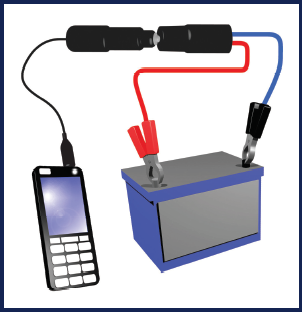
Recharging portable devices
For additional capacity, lead-acid batteries can be wired in parallel: positive terminals tied together; negative terminals tied together. Banks of batteries can power heavier loads such as lights, heaters, or a microwave oven. You should only connect batteries together like this if they are of the same charge level (i.e., fully discharged or fully charged).
Given that lead-acid batteries will likely be your primary source of DC power, you will need an effective method to recharge them. If electrical power is available, such as a generator, then using a conventional battery charger is the quickest method. Note that some battery chargers can charge up parallel batteries concurrently. If your charger won't, then disconnect and charge each battery separately.
If electrical power is not available, you will need an alternative method to recharge your lead-acid batteries. From a practical standpoint, there are three ways to do this: solar arrays, wind turbines, and human-powered machines.
Solar chargers exist for both NiMH and lead-acid batteries. Some chargers fit in the palm of your hand, while others may cover the roof of your home. At first glance, solar power would seem to be the perfect solution to your long-term energy needs. Simply hook your batteries up to the solar charger, and a short time later, your batteries are as good as new, right? Unfortunately, it is not quite that simple.

Solar chargers are very inefficient, taking days or even weeks to recharge batteries.
The problem with solar chargers is the very small amount of power they provide. Consider that small commercial solar chargers, designed to recharge AA and AAA batteries, output about 90 mA of current under full-sun conditions. Assuming six hours of bright sunlight each day, batteries would charge about 540 mA-hours per day. Typical high-capacity AAA and AA batteries are about 900 and 2,500 mA-hours respectively. To fully recharge a set of four AAA batteries would require 3,600 mA-hours, taking about 7 days. Likewise, recharging four AA batteries would require 10,000 mA-hours and take about eighteen days!
The solution to this slow recharge rate is to use larger solar panels. However, most large solar panels are only designed to recharge 12-volt or larger batteries. To charge small NiMH batteries requires you to convert the 12 volts coming off the solar panel to the 1.5-volt level needed for AA or AAA batteries. One method of doing this is to use a recharger, such as the Duracell Mobile Charger, that runs directly off 12 volts. A more general solution is to use an inverter, which allows you to use any recharger with an AC plug.
The problem of minimal solar-panel-energy-yield applies to larger lead-acid batteries as well. A modest solar panel charger measuring 17 in. × 13 in. might provide 400 mA of current in full sunlight. Considering that a heavy duty, lead-acid battery requires about 100 amp-hours, recharging will take 250 hours of full sunlight. If the sun shines with full intensity on the panel for six hours a day, it will take about forty-two days to recharge the battery. If you increase the size of the solar panel to about 50 in. × 40 in., you might get 5 amps of charging current, reducing the recharge time down to a more manageable twenty hours (or three days of bright sunlight).
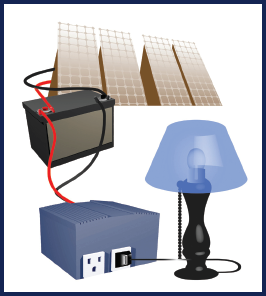
Backup electrical system
The point of the examples is to illustrate that using solar chargers to recharge batteries can be a slow process. The only way around this is to use very large solar panels. Despite this limitation, solar energy can be an excellent source of backup power. Just be realistic in your expectations.
Wind is used to produce about 1.5 percent of the world's energy. In 2009, over 52 terawatt-hours of wind power were produced in the United States.147 Large turbines can now be seen dotting the landscapes of Texas, Colorado, and Oregon. Wind power has become a practical supplement to coal and nuclear energy.

The viability of wind power depends greatly on where you live, and the size and height of the turbine you erect.

Wind turbine
It is important to realize that a turbine's specified power output assumes ideal conditions (perhaps 35-mph winds). Practical yields can easily be a mere 10 percent of the values specified by the manufacturer. A turbine rated with a 400-watt output might only produce an average of 40 watts per hour.
The notable drawbacks to using wind turbines for personal use are cost, availability, and the unpredictable nature of wind. The hardware and installation costs of a small turbine with 26-inch blades and a mounting tower might cost you several thousand dollars. Larger wind generators are significantly more expensive. If a small turbine averages 3 amps of current twenty-four hours a day, it will yield a respectable 72 amp-hours per day—almost enough to recharge a deep cycle, lead-acid battery.
It is possible to convert mechanical energy to electrical energy by moving a permanent magnet through a coil of wire. When doing this, you are mimicking a generator. Three common methods to create this movement are to pedal a specially-equipped bicycle, use a hand pedal, or climb a stair-step machine.

Human-powered machines can create electricity, but the process is slow and arduous.
Bicycles give the greatest energy yield, with units from Windstream Power claiming to produce 10 to 16 amps. Re-charging a 100-amp-hour lead-acid battery would take about six to ten hours of steady pedaling—a very hard day's workout. Hand-pedaled units and stair steppers provide 3 to 4 amps of output power, driving the recharge time up to a whopping twenty-five to thirty-three hours.148
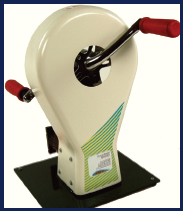
Windstream human-powered generator
There are some advantages to human-powered recharge systems. They are available day and night, and are independent of sun and wind. Also, family members can take turns sharing the work load. The two significant disadvantages are the heavy exertion required and the limited power output.
Quick Summary—Electrical Power
 Having a backup power source can make handling a disaster much easier.
Having a backup power source can make handling a disaster much easier.
 Power can be either direct current (DC) or alternating current (AC). Household appliances and lights run on AC, while most small portable devices use DC power.
Power can be either direct current (DC) or alternating current (AC). Household appliances and lights run on AC, while most small portable devices use DC power.
 Generators and inverters are used to provide AC power.
Generators and inverters are used to provide AC power.
 Determine your electrical needs in order to select the right-sized generator.
Determine your electrical needs in order to select the right-sized generator.
 Either plug directly into your generator using extension cords, or wire the generator to your house through a mechanical interlock or transfer switch.
Either plug directly into your generator using extension cords, or wire the generator to your house through a mechanical interlock or transfer switch.
 Limit fuel use by running your generator only a few hours each day. Develop a schedule of tasks to carry out during each power cycle.
Limit fuel use by running your generator only a few hours each day. Develop a schedule of tasks to carry out during each power cycle.
 Check with your insurance company and fire department to determine how much fuel you are allowed to store.
Check with your insurance company and fire department to determine how much fuel you are allowed to store.
 Add stabilizers to freshly-stored fuel to extend its shelf life.
Add stabilizers to freshly-stored fuel to extend its shelf life.
 Inverters convert battery power into AC power, but are not suited to powering equipment with high startup currents.
Inverters convert battery power into AC power, but are not suited to powering equipment with high startup currents.
 Lithium batteries have the highest capacity and longest shelf life of all single-use or rechargeable batteries. Alkaline are much less expensive, and are good general purpose batteries.
Lithium batteries have the highest capacity and longest shelf life of all single-use or rechargeable batteries. Alkaline are much less expensive, and are good general purpose batteries.
 Low self-discharge NiMH batteries are the only small, rechargeable batteries recommended for disaster preparedness. They are especially useful for powering radios and flashlights.
Low self-discharge NiMH batteries are the only small, rechargeable batteries recommended for disaster preparedness. They are especially useful for powering radios and flashlights.
 When teamed with an inverter and recharger, lead-acid batteries are an excellent emergency power source.
When teamed with an inverter and recharger, lead-acid batteries are an excellent emergency power source.
 Rechargers that use natural energy include solar panels, wind turbines, and human-powered machines. All are viable methods of recharging batteries, but they suffer from limited output.
Rechargers that use natural energy include solar panels, wind turbines, and human-powered machines. All are viable methods of recharging batteries, but they suffer from limited output.
Recommended Items—Electrical Power
 Backup power source
Backup power source
a. Electric generator system including: a gas or diesel generator, interlock or transfer switch, power inlet box, heavy-duty power cord, and maintenance items (e.g., filters, spark plugs), and/or
b. Bank of deep cycle batteries, conventional charger, high-wattage inverter, and extension cords
 Backup fuel source
Backup fuel source
a. Gas or diesel fuel in approved storage containers, treated with a stabilizer, and/or
b. Solar, wind, or mechanical battery recharger
 Spare batteries
Spare batteries
a. Alkaline, or
b. Low self-discharge rechargeable NiMH batteries with recharger